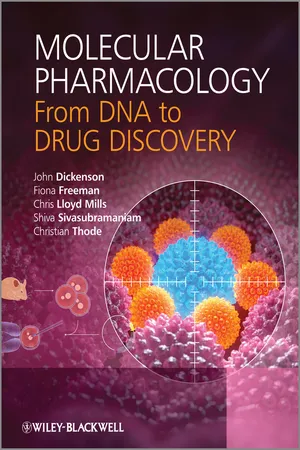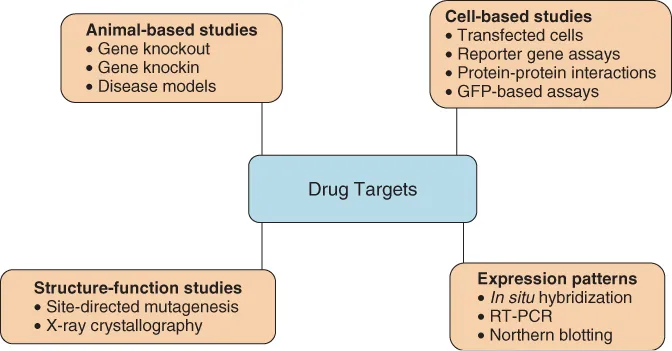![]()
Chapter 1
Introduction to Drug Targets and Molecular Pharmacology
1.1 Introduction to molecular pharmacology
1.2 Scope of this textbook
1.3 The nature of drug targets
1.4 Future drug targets
1.5 Molecular pharmacology and drug discovery
References
1.1 Introduction to molecular pharmacology
During the past 30 years there have been significant advances and developments in the discipline of molecular pharmacology—an area of pharmacology that is concerned with the study of drugs and their targets at the molecular or chemical level. Major landmarks during this time include the cloning of the first G-protein coupled receptor (GPCR) namely the β2-adrenergic receptor in 1986 (Dixon et al., 1986). This was quickly followed by the cloning of additional adrenergic receptor family genes and ultimately other GPCRs. The molecular biology explosion during the 1980s also resulted in the cloning of genes encoding ion channel subunits (e.g. the nicotinic acetylcholine receptor and voltage-gated Na+ channel) and nuclear receptors. The cloning of numerous drug targets continued at a pace during the 1990s but it was not until the completion of the human genome project in 2001 that the numbers of genes for each major drug target family could be determined and fully appreciated. As would be expected, the cloning of the human genome also resulted in the identification of many potentially new drug targets. The completion of genome projects for widely used model organisms such as mouse (2002) and rat (2004) has also been of great benefit to the drug discovery process.
The capacity to clone and express genes opened up access to a wealth of information that was simply not available from traditional pharmacology-based approaches using isolated animal tissue preparations. In the case of GPCRs detailed expression pattern analysis could be performed using a range of molecular biology techniques such as in situ hybridisation, RT-PCR (reverse transcriptase-polymerase chain reaction) and Northern blotting. Furthermore having a cloned GPCR gene in a simple DNA plasmid made it possible for the first time to transfect and express GPCRs in cultured cell lines. This permitted detailed pharmacological and functional analysis (e.g. second messenger pathways) of specific receptor subtypes in cells not expressing related subtypes, which was often a problem when using tissue preparations. Techniques such as site-directed mutagenesis enable pharmacologists to investigate complex structure-function relationships aimed at understanding, for example, which amino acid residues are crucial for ligand binding to the receptor. As cloning and expression techniques developed further it became possible to manipulate gene expression in vivo. It is now common practice to explore the consequences of deleting a specific gene either from an entire genome (knockout) or from a specific tissue/organ (conditional knockout). It is also possible to insert mutated forms of genes into an organism's genome using knockin technology. These transgenic approaches allow molecular pharmacologists to study developmental and physiological aspects of gene function in vivo and in the case of gene knockin techniques to develop disease models.
The molecular biology revolution also enabled the development of novel approaches for studying the complex signal transduction characteristics of pharmacologically important proteins such as receptors and ion channels. These include reporter gene assays, green fluorescent protein (GFP) based techniques for visualising proteins in living cells and yeast two hybrid-based assays for exploring protein-protein interactions. You will find detailed explanations of these and other current molecular-based techniques throughout this textbook. Another major breakthrough in the 2000s was the development of methods that allowed high resolution structural images of membrane-associated proteins to be obtained from X-ray crystallography. During this time the first X-ray structures of GPCRs and ion channels were reported enabling scientists to understand how such proteins function at the molecular level. Indeed crystallography is an important tool in the drug discovery process since crystal structures can be used for in silico drug design. More recently researchers have used NMR spectroscopy to obtain a high-resolution structural information of the β2-adrenergic receptor (Bokoch et al., 2010). A distinct advantage of NMR-based structural studies, which are already used for structural studies of other drug targets such as kinases, would be the ability to obtain GPCR dynamics and ligand activation data which is not possible using X-ray based methods. Some of the molecular pharmacology based approaches used to interrogate drug targets are outlined in Figure 1.1.
Despite this increased knowledge of drug targets obtained during the molecular biology revolution, there has been a clear slowdown in the number of new drugs reaching the market (Betz, 2005). However, since it takes approximately 15 years to bring a new drug to market it may be too early to assess the impact of the human genome project on drug discovery. In 2009 the global pharmaceutical market was worth an estimated $815 billion. However during the next few years a major problem facing the pharmaceutical industry is the loss of drug patents on key blockbusters. The hope for the future is that the advances in molecular pharmacology witnessed during the last decade or so will start to deliver new blockbuster therapeutics for the twenty-first century.
1.2 Scope of this textbook
As briefly detailed above there have been numerous exciting developments in the field of molecular pharmacology. The scope of this textbook is to explore aspects of molecular pharmacology in greater depth than covered in traditional pharmacology textbooks (summarised in Figure 1.2). Recent advances and developments in the four major human drug target families (GPCRs, ion channels, nuclear receptors and transporters) are covered in separate chapters (Chapters 3–5 and 8). The molecular targets of anti-infective drugs (anti-bacterial and anti-viral) whilst of great importance are not covered in this book. Other chapters deal with the cloning of drug targets (Chapter 2) and transgenic animal technology (Chapter 10). The concept of gene therapy is explored in a case study-based chapter which looks at current and possible future treatment strategies for cystic fibrosis, the commonest lethal genetic disease of Caucasians (Chapter 6). Another major development in molecular pharmacology has been the discipline of pharmacogenomics: the study of how an individual's genetic makeup influences their response to therapeutic drugs (Chapter 7). These naturally occurring variations in the human genome are caused predominantly by single nucleotide polymorphisms (DNA variation involving a change in a single nucleotide) and there is a major research consortium aimed at documenting all the common variants of the human genome (The International HapMap project). The information from the project, which is freely available on the internet, will enable scientists to understand how genetic variations contribute to risk of disease and drug response. Finally, we take an in depth look at the role of calcium in the cell, looking at techniques used to measure this important second messenger (Chapter 9).
1.3 The nature of drug targets
How many potential drug targets are there in the human genome? This is an important question often asked by the pharmaceutical industry since they are faced with the task of developing novel therapeutics for the future. When the draft sequence of the human genome was completed in 2001 it was estimated to contain approximately 31,000 protein-coding genes. However since its completion the number of human protein-coding genes has been continually revised with current estimates ranging between 20,000 and 25,000. Of these it is predicted that about 3000 are feasible protein drug targets. In 2005 it was calculated that about 100 drug targets account for all prescription drugs. On this basis there is obviously considerable scope for the development and discovery of novel drug targets to treat disease. At present the classical drug targets include GPCRs (Chapter 3), ion channels (Chapter 4), nuclear receptors (Chapter 8), transporters (Chapter 5) and enzymes. These important classical drug targets, whilst briefly covered in this Intro...


